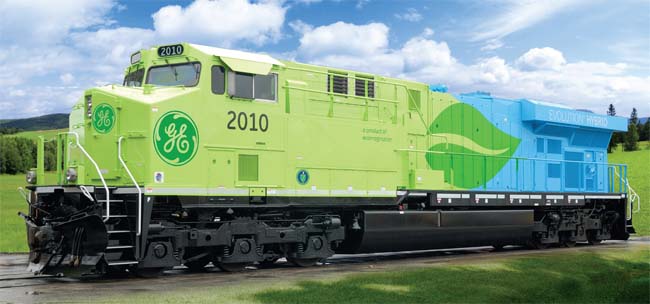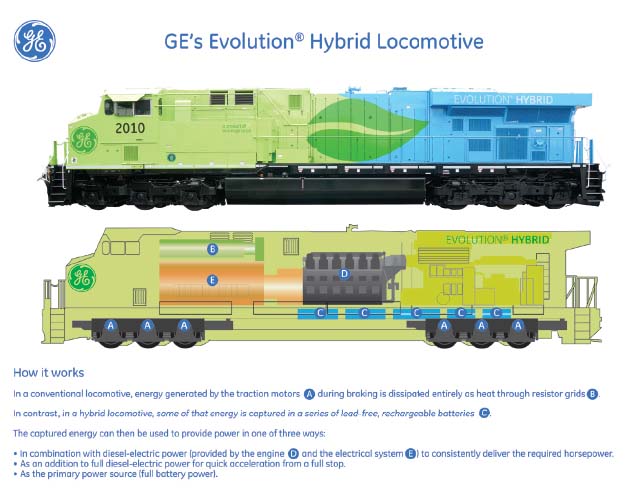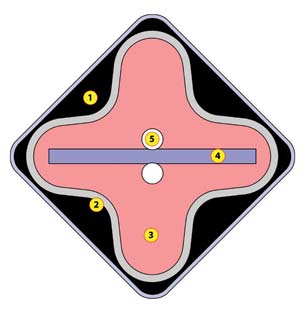COMSOL Multiphysics Models Hybrid Locomotive
Simulation that Will Change the World, Honorable Mention: GE jumps on the green train by modeling a battery with COMSOL Multiphysics.
Latest News
December 1, 2009
By Phil Byrne
If all diesel electric locomotives in the U.S. were converted to hybrid technology, more than $425 million per year in fuel costs could be saved. Add this to significant cuts in greenhouse gas emissions (the reduction in one locomotive in one year would equal the emissions of 2,600 cars) and the environmental savings of General Electric’s Hybrid Locomotive help move us toward a greener tomorrow as the economic savings help the bottom line of rail companies.
 General Electric’s Ecomagination technology is exemplified by the Evolution Hybrid Locomotive driven, in part, by batteries developed with the help of COMSOL Multiphics simulation software. |
For years, fuel cells had been pushed as the answer for “green” transport even though a commercially viable vehicle was never fully realized. Rather than waiting for a hydrogen economy to be established, hybrid cars such as the Toyota Prius, Ford Escape, Chevrolet Malibu, and others have shown that a simpler and better use of existing technologies can also lead to substantial improvements in the environmental credentials of a vehicle. Best of all, they’re available now.
Such vehicles, with their repetitive start-stop operation, are an application where hybridized internal combustion/electric drives are more efficient than internal combustion engines alone. But consumers of automobiles might not have suspected that a battery-driven electric locomotive would be practical. After all, a train moves heavy loads at fast speeds for long periods and over long distances. Surprisingly, though, batteries can make a substantial contribution to a train’s power needs, given that they can provide up to 2,000 horsepower to a locomotive.
Recovered Energy Cuts Emissions
“One large difference compared to an automobile is that locomotives spend many minutes while dynamic braking, rather than just seconds. This generates considerable energy that’s normally lost,” says Michael Vallance of GE Global Research. Vallance is simulating the sodium metal-chloride batteries that will drive GE’s hybrid locomotives with COMSOL Multiphysics.
 A locomotive expends considerable energy when braking. In hybrid locomotives, this energy is harnessed and stored by batteries (C) and can be used as the primary source or as a supplement to the energy created by the engine. Image courtesy of GE Transportation |
The plan is to make use of this braking energy to generate electricity in hybrid locomotives to achieve fuel savings of up to 15 percent, the equivalent of 25,000 to 30,000 gallons of diesel per vehicle per year or more than 300,000kg of CO2 emissions. Moreover, the reduction in NOx emissions is even more significant.
However, GE had to develop an alternate to the lithium and metal-hydride batteries used in passenger vehicles. They needed versions with higher energy densities to withstand the harsher environment of a long-haul locomotive. Furthermore, these new batteries must be tolerant of cell failures in high-voltage strings, where batteries with failed cells continue to operate safely and effectively.
To develop its own high-temperature sodium metal-chloride battery, GE formed a design team spanning its Global R&D laboratories, with members in Niskayuna, NY; Shanghai, China; and Bangalore, India. This team began a close collaboration with the engineers of GE Transportation in Erie, PA. As a result, GE’s battery technology has reached the stage where a full-scale prototype of an operational locomotive is being used to display the technology to potential customers. In fact, back in 2007, GE demonstrated its first working hybrid freight locomotive by piloting one to Los Angeles’ Union Station with company CEO Jeff Immelt on board.
 A cross-section of the battery geometry and the various modeling domains: 1) Anode of molten sodium; 2) BASE of sodium conducting solid electrolyte (b’’ alumina); 3) Cathode of iron and molten-salt electrolyte (NaCl-saturated sodium tetrachloroaluminate (STCA)); 4) STCA reservoir; and 5) Cathode current collector. |
A Valuable Tip
Vallance and his colleagues began to look for a modeling software package that was well suited to simulating the electrochemical reactions, materials, and energy transport that make up the sodium metal-chloride battery to better understand the mechanisms that make it function. One option raised was the COMSOL Multiphysics software platform.
Vallance attended a COMSOL Conference in 2007 to learn more about the software. At the conference he also met one of the leading experts in electrochemical simulations, Dr. Ralph E. White from the Department of Chemical Engineering at the University of South Carolina. White was able to advise Vallance on how to include advanced electrochemical phenomena in his models.
To fully simulate the operational behavior of a sodium metal-chloride battery, you must involve multiple mechanisms. Electrochemical reaction kinetics as described by the Butler Volmer equations need to be solved at the electrodes, while the model must also consider the transport of ions to these electrodes through migration, diffusion, and convection. A number of participating materials change phase as a part of the battery’s charging or discharging operations, and the corresponding kinetics must also be factored in. Furthermore, temperature plays an important role in many of the battery’s physical characteristics, including ionic mobility and the species’ phases, so operational temperatures must be held within a narrow range. Considering all of these factors, COMSOL Multiphysics’ ability to couple and solve them simultaneously was a key feature in the team’s decision to use the software and led to development of an accurate and realistic battery model.
Understanding Leads to Design Changes
The models Vallance created have uncovered results that led to a heightened understanding of the battery. In the present version of the battery, the modelers have been able to identify areas of high current density, and this information was used to adjust manufacturing tolerances at critical regions. The model provided additional insights concerning convective flows in the cathode, which lead to an experimental investigation of modified geometries. The value of modeling even extends into operating issues. Plotting cell resistance versus depth of discharge (DoD–the extent to which the reacting materials in the battery are consumed) indicates when operators should start a recharging cycle. Because cell resistance starts to rise exponentially after about 60 percent DoD, a battery should not be discharged long beyond this point. COMSOL Multiphysics will also be useful for investigating other properties such as the battery’s structural integrity due to vibrations and other duress it experiences in the locomotive.
By using COMSOL Multiphysics, Vallance’s team hopes to show rail transportation companies how they can save even more in energy costs than first thought at the same time they help reduce emissions of toxic greenhouse gases.
More Info:
COMSOL, Inc.
Philip Byrne holds a Ph.D. in electrochemical engineering from the Royal Institute of Technology, Stockholm, Sweden. He is quality manager at COMSOL. Send comments to [email protected].
Subscribe to our FREE magazine, FREE email newsletters or both!
Latest News
About the Author
DE’s editors contribute news and new product announcements to Digital Engineering.
Press releases may be sent to them via [email protected].






